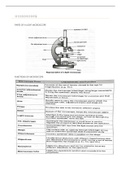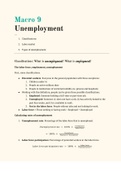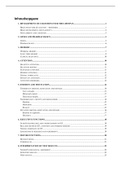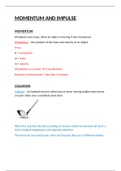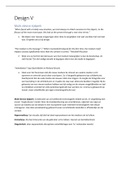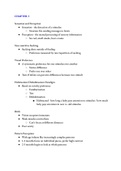Ecology
Lecture 11 Community Ecology 1 23/03/21
Defining a community
- A group of interacting species that occur together at the same place and time.
- The interactions are synergistic: they make communities into something more than the sum
of their parts.
- Human body and limbs/organs – all work together to produce a functioning human.
- Thus a community is dependent on the species that are present and how they interact with
one another and their physical surroundings.
- In reality, ecologists delineate communities based on physical or biological characteristics.
- Physical characteristics: all the species in a river, desert or location.
- Biological characteristics: all the species associated with key dominant organisms or different
habitats.
- Another way of sub-dividing a community is to base it on taxonomic affinity, such as guilds (a
group of organisms that use the same resource), or functional groups (a sub-set of the
community that has species that function in similar ways but do not use the same resource).
- Often, sub-dividing a community forms an arbitrary delineation. It depends on the nature of
the study, and also communities can have distinct boundaries or gradual boundaries.
Measuring a community structure
- The number of species: the simplest measure of species diversity, called species richness. It
is an okay measure, but it has limitations.
- So, we need a measure that takes into account the number of species and their relative
abundance. These are diversity indices. The most common are Simpson’s index and Shannon
index.
s
- Shannon index: H=−∑ p i ln (¿ pi)¿ , where H is the Shannon index value, P i is the
i=1
proportion of species found in the ith species, ln is the natural logarithm, and s is the
number of species in the community.
s
( ni ( n−1 ) )
- Simpson’s Diversity index: DS =∑ . This is a dominance index: they are
i−1 ( N ( N −1 ) )
weighted towards the commonest species. Common species influence estimates of diversity
more heavily than rare species do. Ds is Simpson’s diversity index, s is the number of species
present, ni is the number of individuals of each species, i-1 means you do the calculation for
each species (then add all the values together), and N is the number of individuals. It is
usually expressed as 1/Ds. Bigger number = more diversity.
- Generally, the values are correlated, so high Shannon index results in a high Simpson index
and vice versa.
Taxon accumulation curves
- A useful tool for understanding how many samples to
take.
- If we threw one quadrat on the lawn outside, we might
record 6 different species of plant.
- If we threw it again, we might find 8 species of plant,
but three of these might already have been ‘discovered’
Lecture 11 Community Ecology 1 23/03/21
Defining a community
- A group of interacting species that occur together at the same place and time.
- The interactions are synergistic: they make communities into something more than the sum
of their parts.
- Human body and limbs/organs – all work together to produce a functioning human.
- Thus a community is dependent on the species that are present and how they interact with
one another and their physical surroundings.
- In reality, ecologists delineate communities based on physical or biological characteristics.
- Physical characteristics: all the species in a river, desert or location.
- Biological characteristics: all the species associated with key dominant organisms or different
habitats.
- Another way of sub-dividing a community is to base it on taxonomic affinity, such as guilds (a
group of organisms that use the same resource), or functional groups (a sub-set of the
community that has species that function in similar ways but do not use the same resource).
- Often, sub-dividing a community forms an arbitrary delineation. It depends on the nature of
the study, and also communities can have distinct boundaries or gradual boundaries.
Measuring a community structure
- The number of species: the simplest measure of species diversity, called species richness. It
is an okay measure, but it has limitations.
- So, we need a measure that takes into account the number of species and their relative
abundance. These are diversity indices. The most common are Simpson’s index and Shannon
index.
s
- Shannon index: H=−∑ p i ln (¿ pi)¿ , where H is the Shannon index value, P i is the
i=1
proportion of species found in the ith species, ln is the natural logarithm, and s is the
number of species in the community.
s
( ni ( n−1 ) )
- Simpson’s Diversity index: DS =∑ . This is a dominance index: they are
i−1 ( N ( N −1 ) )
weighted towards the commonest species. Common species influence estimates of diversity
more heavily than rare species do. Ds is Simpson’s diversity index, s is the number of species
present, ni is the number of individuals of each species, i-1 means you do the calculation for
each species (then add all the values together), and N is the number of individuals. It is
usually expressed as 1/Ds. Bigger number = more diversity.
- Generally, the values are correlated, so high Shannon index results in a high Simpson index
and vice versa.
Taxon accumulation curves
- A useful tool for understanding how many samples to
take.
- If we threw one quadrat on the lawn outside, we might
record 6 different species of plant.
- If we threw it again, we might find 8 species of plant,
but three of these might already have been ‘discovered’

